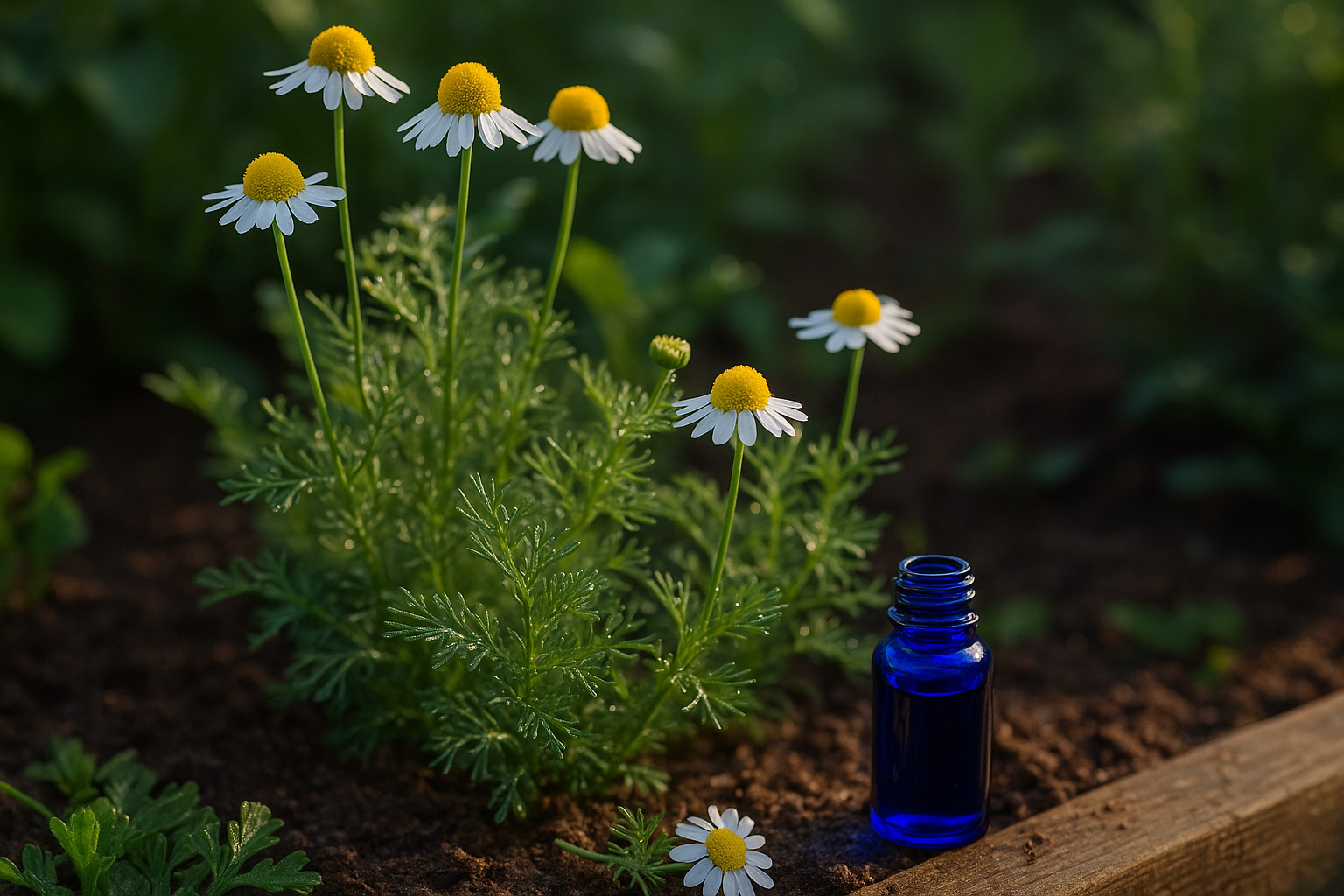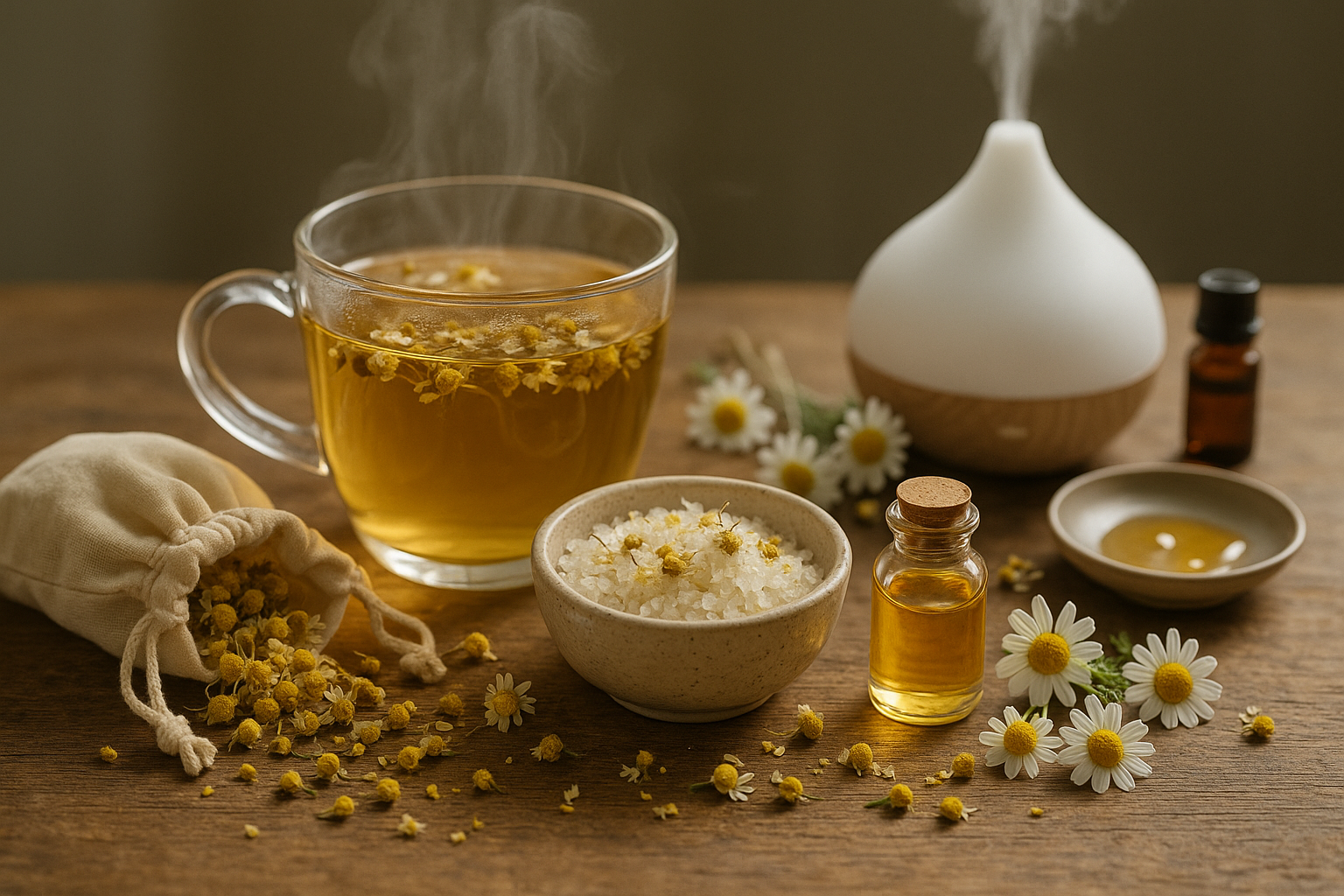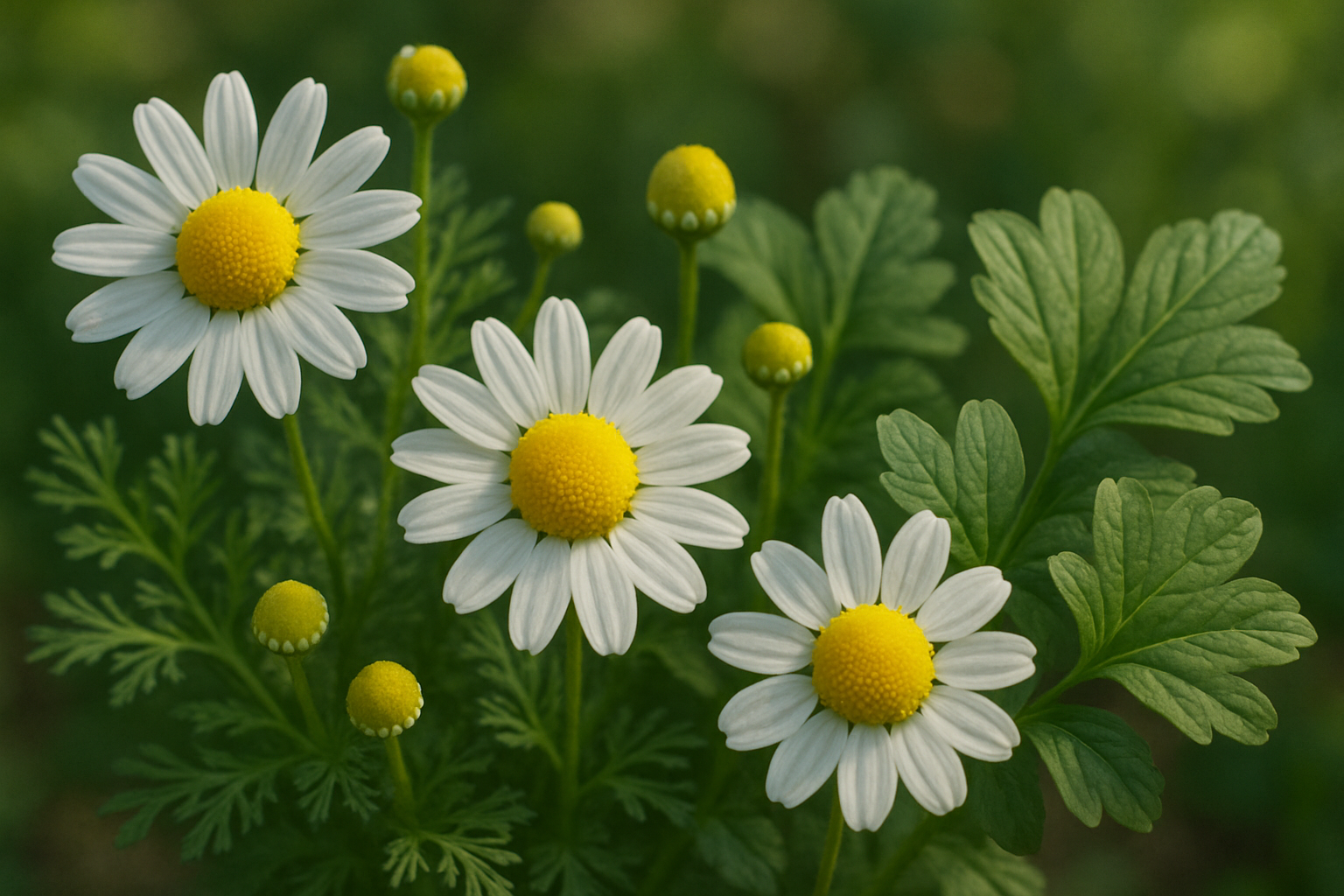Introduction
If you’ve ever browsed the tea aisle or searched for herbal remedies, you’ve probably come across debates about “German vs. Roman chamomile” on labels and wellness blogs. Chamomile, a soothing herbal plant used for centuries, comes in two main forms: German chamomile (Matricaria recutita) and Roman chamomile (Chamaemelum nobile).
At first glance, these flowers look alike and both offer calming properties, but they differ in ways that affect their uses, effects, and even flavor. The confusion is common—many people use “chamomile” as a catch-all term, not realizing that choosing between German and Roman chamomile can make a difference depending on your needs.
Knowing the difference can help you select the right herb for better sleep, healthier skin, and targeted relaxation. In this post, you’ll discover what makes German and Roman chamomile unique, practical tips for identifying them, and which type to choose for your favorite teas, essential oils, and home remedies. Whether you’re a natural wellness enthusiast or just want to get more from your chamomile products, understanding these distinctions will make you a savvier, more satisfied consumer.
German Chamomile

German chamomile, known botanically as Matricaria chamomilla or Matricaria recutita, is a small, daisy-like annual herb prized for both its delicate beauty and potent benefits. Easily recognized by its feathery foliage and white petals surrounding a vivid yellow center, German chamomile thrives in well-drained, sunny plots throughout Europe, western Asia, and now North America.
One of its standout features is its high essential oil content—especially chamazulene, a compound that gives the oil its striking deep blue color and strong anti-inflammatory properties. Its fresh scent is sweet, apple-like, and calming, making it a favorite in aromatherapy blends.
The flowers are rich in other key components like bisabolol and flavonoids, which are well-known for soothing the skin and supporting digestive health. This versatility explains why German chamomile is a staple in calming herbal teas—helping to ease stress and settle stomachs—as well as in a wide array of skincare products for sensitive or irritated skin.
Natural wellness brands often choose German chamomile over Roman chamomile for products like balms or oils, thanks to its higher therapeutic potency and more pronounced azulene content. If you’re looking to use chamomile for relaxation, gastrointestinal comfort, or gentle skincare, look for labels that specify “German chamomile” to enjoy its superior calming, anti-inflammatory, and antioxidant effects.
Roman Chamomile
Roman chamomile, known botanically as Chamaemelum nobile, is a perennial herb native to Western Europe and North Africa. It is recognized for its feathery leaves and daisy-like white flowers with a yellow center. This low-growing plant thrives in temperate climates, often flourishing in well-drained, sandy soils and sunny gardens.
Unlike its cousin, German chamomile (Matricaria recutita), Roman chamomile is a perennial and tends to be shorter with a creeping habit. Its aroma is distinctively sweet and apple-like, which is also reflected in its pleasantly mild, slightly bitter taste when brewed.
Roman chamomile’s key active compounds include esters such as angelic acid, tiglic acid, and isobutyl angelate, which are credited for its calming and anti-inflammatory effects.
Uses and Benefits
In practice, Roman chamomile is a go-to ingredient for herbal teas aimed at easing stress and supporting sleep. It is also popular in digestive blends to soothe mild discomfort. Its essential oil is frequently used in aromatherapy to promote relaxation and reduce anxiety. Additionally, it is a favorite in natural skincare, often added to creams and ointments for its gentleness on sensitive or irritated skin.
Why Choose Roman Chamomile?
Roman chamomile is often preferred over German chamomile in situations requiring a milder, less pungent profile—especially in aromatherapy blends intended for children or those with sensitivities. It is also better suited for long-term ornamental planting in gardens due to its perennial growth.
Whether you’re steeping a calming cup of tea, preparing a soothing bath, or looking for a gentle skin remedy, Roman chamomile stands out for its versatility and gentle nature.
German Chamomile vs Roman Chamomile
German chamomile (Matricaria chamomilla) and Roman chamomile (Chamaemelum nobile) are often confused, but they have distinct traits that might affect your choice—whether you’re gardening, making teas, or seeking essential oils.
Appearance
German chamomile is taller, growing up to 24 inches, with finely divided, feathery leaves and small, delicate daisy-like flowers featuring prominent yellow centers and sparse white petals. In contrast, Roman chamomile is a low-growing perennial—often used as ground cover—reaching just 4-12 inches, with broader, coarser foliage and slightly larger, more robust daisy blooms.
Flower Structure
The flower structure also differs: German chamomile’s flower heads are hollow inside, whereas Roman chamomile’s are solid. This small detail helps with quick identification.
Growth Habits
German chamomile is usually an annual that reseeds itself easily, thriving in disturbed soils and sunny spots. Roman chamomile, on the other hand, is a perennial that persists year after year, preferring cooler weather, partial shade, and well-drained soil.
Scent and Flavor
The scents are another key distinguisher: German chamomile gives off a sweet, apple-like aroma—often described as fresh and mildly sweet—while Roman chamomile’s scent is earthier, more herbal, and may carry a hint of bitterness. These qualities influence their flavors as well: German chamomile teas are light, floral, and softly sweet, popular for soothing nighttime blends. Roman chamomile has a stronger, more bitter flavor profile, sometimes preferred in traditional remedies.
Essential Oils
Even their essential oils differ in color. German chamomile oil is distinctively blue due to chamazulene, a powerful anti-inflammatory compound, while Roman chamomile oil ranges from pale yellow to clear.
Usage and Preferences
Despite these differences, both chamomiles are cherished for their gentle, relaxing properties and are generally considered safe for most people, including children, pregnant women, and the elderly—when used as directed. For consumers, the choice often comes down to personal preference and intended use:
- Choose German chamomile for its sweet flavor and vibrant blue oil.
- Opt for Roman chamomile if you need a hardy ground cover or prefer a stronger herbal aroma in your remedies.
Health Benefits of Chamomile
Chamomile has long been valued in traditional remedies, and modern science continues to reveal how this unassuming flower can positively impact our health. One of its most widely recognized benefits is its calming effect. Several clinical studies support chamomile—particularly German chamomile (Matricaria chamomilla)—for promoting better sleep quality.
Drinking chamomile tea or using chamomile extracts before bedtime has helped participants fall asleep faster and improve overall sleep satisfaction, making it a gentle alternative for those struggling with insomnia.
Chamomile’s soothing properties don’t end with sleep: the herb is also known to ease mild anxiety. Research points to compounds in German chamomile, like apigenin, which bind to brain receptors associated with relaxation, potentially lowering levels of stress and tension.
For those with digestive issues, chamomile offers promise as well—its anti-inflammatory and antispasmodic properties have been shown to calm upset stomachs, reduce gas, and relieve mild symptoms of irritable bowel syndrome (IBS).
Both German and Roman chamomile (Chamaemelum nobile) share many of these benefits, but German chamomile tends to be used more often in research and commercial supplements due to its higher concentration of active phytochemicals. Roman chamomile, however, is especially favored for topical and aromatherapeutic uses, such as soothing skin irritation or promoting emotional balance.
While chamomile is generally safe for most people, there are some caveats:
- Individuals with allergies to plants in the daisy family (like ragweed) may experience reactions.
- Chamomile can interact with blood-thinning medications and certain sedatives.
- Pregnant and breastfeeding women are advised to use caution, as robust safety data is still limited.
As with any supplement or herbal remedy, it’s best to consult your healthcare provider before adding chamomile to your routine, especially if you have existing conditions or take prescription medications.
Which Chamomile Is Right For You?
Choosing the right chamomile depends on your intended use and personal preferences, but the good news is there’s a variety suited for almost everyone.
If you’re making tea, German chamomile (Matricaria recutita) is usually preferred for its sweet, apple-like flavor and strong potency—it’s what you’ll find in most chamomile tea bags and loose blends. Roman chamomile (Chamaemelum nobile), on the other hand, has a milder, slightly bitter taste and is often used for aromatherapy and skincare due to its soothing properties and gentle scent.
For topical uses like skincare balms or calming essential oils, Roman chamomile is often the go-to because it’s gentle on the skin and less likely to cause irritation, making it especially useful if you have sensitive skin or are prone to allergies (though always do a patch test first).
For diffusers or aromatherapy blends, either type can work, but Roman chamomile’s light, apple-fresh aroma is favored for relaxation and sleep.
If you’re sensitive to ragweed, it’s important to note that both types of chamomile can trigger allergies, so stick with a patch test or consult your doctor before trying.
As a simple decision guide:
- Choose German chamomile for bold, comforting tea.
- Choose Roman chamomile for gentle skin care and subtle aromatherapy.
- Always consider any scent or allergy sensitivities you may have.
Mixing both varieties can give you the best of both worlds, so feel free to experiment to find your perfect match.
How to Use Chamomile in Everyday Life

Chamomile is a versatile herb that can effortlessly enhance your daily routine, whether you’re using the German or Roman varieties. Both types are prized for their calming properties—think soothing tea, relaxing baths, gentle skincare, and even aromatic diffusers.
To brew classic chamomile tea, simply steep one tablespoon of dried German or Roman chamomile flowers in a cup of just-boiled water for 5–10 minutes. Add a touch of honey or lemon for extra flavor.
For a stress-relieving bath soak, toss a handful of dried chamomile flowers—German is especially fragrant—into a muslin bag or directly under running water. You can also mix them with Epsom salts and lavender for added relaxation.
In skincare, infuse chamomile flowers in carrier oils (like jojoba) for a week or two, then strain and use as a calming facial oil. Alternatively, add the infusion to homemade creams to reduce redness and irritation—Roman chamomile is especially gentle for sensitive skin.
Diffusing a few drops of chamomile essential oil, or blending it with lavender and sweet orange oils, makes any space feel serene.
When shopping for chamomile, look for fragrant, whole, golden-yellow flowers with minimal stems. Choose certified organic and pesticide-free brands whenever possible. Avoid products with a musty smell, faded color, or excessive powder.
Whether sipped, soaked, smoothed on, or inhaled, a little chamomile goes a long way in turning everyday rituals into moments of calm.
Conclusion
In summary, German and Roman chamomile both offer impressive calming and soothing benefits, but they differ in subtle ways. German chamomile is best known for its deep blue oil and strong anti-inflammatory qualities, making it excellent for skin care and easing discomfort. Roman chamomile, with a milder scent, shines for relaxation and gentle support in teas or aromatherapy.
Both types are safe and versatile, so choosing between them depends on your personal preferences and needs. Don’t hesitate to sample both to discover which works best for you—enjoy exploring the natural benefits each chamomile variety brings!
